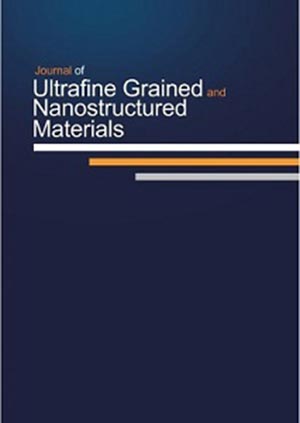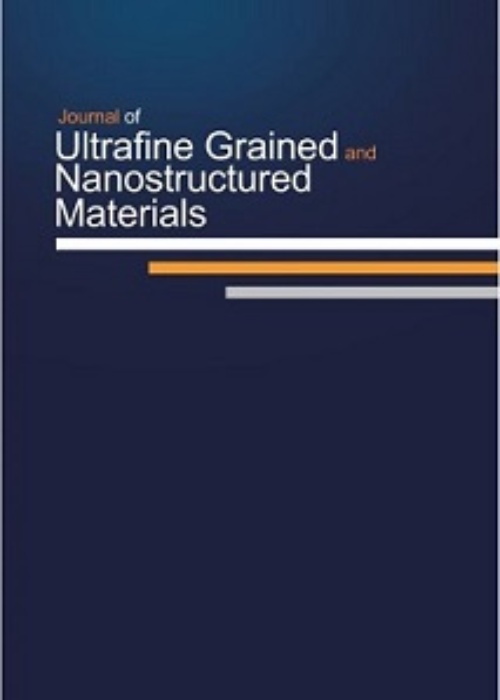فهرست مطالب

Journal of Ultrafine Grained and Nanostructured Materials
Volume:45 Issue: 1, Jun 2012
- تاریخ انتشار: 1391/08/20
- تعداد عناوین: 10
-
-
Page 1This paper provides an overview on obtaining low-carbon ultra-fine grained dual-phase steels through rapid intercritical annealing of cold-rolled sheet as improved materials for automotive applications. A laboratory processing route was designed that involves cold-rolling of a tempered martensite structure followed by a second tempering step to produce a fine grained aggregate of ferrite and carbides as the initial microstructure for rapid intercritical annealing. The intercritical annealing step was performed with heating and cooling rates of at least 100 °C/s and a holding time of 30 s. The intercritical temperature was selected to result in 20- 35% martensite in the final microstructures for C-Mn steels with carbon contents of 0.06, 0.12 and 0.17 wt%, respectively. The proposed processing routes produced an ultra-fine grained ferrite-martensite structure withgrain sizes of approximately 1 μm for all three steels. The tensile strength of these ultra-fine grained dualphase steels can be increased by up to 200 MPa as compared to coarse-grained dual-phase steels while maintaining uniform elongation values. The rather narrow processing window necessary to obtain these properties was evaluated by determining the effect of intercritical annealing conditions on microstructure evolution. Further, the experimental results were confirmed with phase field simulations of austenite formation indicating that rapid heat treatment cycles are essential to obtain fine grained intercritical austenite that leads to martensite islands with sizes of 1 μm and below in the final microstructure.Keywords: Phase field modelling, Grain refinement, Low, carbon steels, Intercritical annealing, Mechanical properties
-
Page 7Recently, the Al2O3–TiO2–ZrO2 system has found valuable applications, particularly, as a support for NOx storage–reduction (NSR) catalysts. Nanocomposite powders were prepared from the co precipitation method in inorganic precursors. The behaviors of mixed oxide nanoparticles under ultrasonic irradiation, such as dispersion, and crushing were studied. Phase transformations, crystallite size, and microstructure of the mixed oxides were investigated by STA (DTA/TG), FTIR, XRD, and SEM. XRD studies showed that zirconium titanate (ZT) is main phase, and the crystallite size varies with the final calcination temperature, and ultrasonic irradiations. SEM observations revealed that the calcination temperature strongly influences the morphology of prepared mixed oxides. The results showed that the inorganic nanoparticles in the aqueous solution can be redispersed more effectively by ultrasonic irradiation than by conventional stirring. The average crystallite sizes of the ZT particles heat treated at 1200 °C for 2 h were in the range of 47-85 nm.Keywords: Ultrasonic, Co, precipitation, FTIR
-
Page 13Carbon nanotube (CNT) is considered as a new generation of material possessing superior mechanical, thermal and electrical properties. The applications of CNT, especially in composite materials, i.e. carbon nanotube reinforced polymer have received great attention and interest in recent years. To characterize the influence of CNT on the stress intensity factor of nanocomposites, three fracture modes (opening, shearing and tearing) are considered. The stress intensity factor of nanocomposites is evaluated using a representative volume element (RVE) based on the continuum mechanics and finite element method (FEM). Inter atomic interactions of CNT are simulated by beam elements in the finite element (FE) model. Non-linear springbased line elements are employed to simulate the van der Waals (vdW) bonds. In all fracture modes, the stress intensity factor was determined for pure matrix and matrix reinforced with single-walled carbon nanotube (SWCNT). Numerical results indicate that the load carrying capacities of the CNTs in a matrix are evident. Addition of CNTs in a matrix can increase the stiffness of the composite. Finally, the results showed that utilizing of SWCNT decreased the stress intensity factor and improved crack resistance.Keywords: Finite element model, Carbon nanotubes, Fracture modes, Stress intensity factor, Nanocomposite
-
Page 19Excellent mechanical properties of carbon nanotubes (CNTs) make them outstanding candidate reinforcements to enhance mechanical properties of conventional composites. The glass/polyester composites are widely used in many industries and applications. Improving the mechanical properties of such composites with addition of CNTs can increase their applications. In this research, multi-walled carbon nanotube (MWCNT) at different weight ratios (0.05, 0.1, 0.3, 0.5 wt.%) were added to chopped strand mat (CSM)/Polyester composites. Mechanical stirring with the aid of sonication technique were used to achieve a good dispersion state of MWCNTs in the polymeric matrix. The specimens were fabricated by the hand layup method. It is assumed that a high level of dispersion in the preparation stage may lead to better mechanical properties of the nanocomposite. Scanning electron microscopy (SEM) was employed to determine the dispersion state of carbon nanotubes in the matrix. Mechanical tests (tensile and flexural) were performed in order to evaluate the effects of adding MWCNT on CSM/Polyester composites. The results exhibit improvements in flexural strength while the values of tensile strength do not show significant changes. Although addition of filler at all above ratios increased the flexural strength, introducing only 0.05 wt.% MWCNT into the CSM/Polyester composites enhanced the flexural strength by 45%. Moreover, improvements in Young''s and flexural moduli were observed.Keywords: Multi, walled carbon nanotube, Polyester, Chopped strand mat, Mechanical properties
-
Page 23We explore electro-catalytic properties of a system consisting of platinum and palladium nanoparticles dispersed over a nanotubular self-organized TiO2 matrix. These electrodes prepared by electroess and microemulsion of palladium and palladium nanoparticles on to TiO2 nanotubes, respectively. Titanium oxide nanotubes were fabricated by anodizing titanium foil in ethylene glycol (EG) fluoride-containing electrolyte. The morphology and surface characteristics of Pd-TiO2/Ti and Pt-TiO2/Ti electrodes were investigated using scanning electron microscopy (SEM) and energy-dispersive X-ray spectroscopy (EDX), respectively. The results indicated that platinum and palladium nanoparticles were homogeneously deposited on the surface of TiO2 nanotubes. The nanotubular TiO2 layers consist of individual tubes of 70-90 nm diameters. This nanotubular TiO2 support provides a high surface area and it significantly enhances the electro catalytic activity of Pd-TiO2/Ti and Pt-TiO2/Ti electrodes for alcohols oxidation. The electro-catalytic activity of Pd- TiO2/Ti and Pt-TiO2/Ti electrodes in the alcohols electro-oxidation was studied by electrochemical methods. The results indicate that Pd-TiO2/Ti and Pt-TiO2/Ti electrodes improve the electro-catalytic activity for alcohols oxidation greatly and confirmed the better electro-catalytic activity and stability of these new electrodes. So, the Pd-TiO2/Ti and Pt-TiO2/Ti electrodes have a good application potential to fuel cells.Keywords: TiO2 nanotubes, Palladium nanoparticle, Fuel cells, Alcohols electrooxidation, Platinum nanoparticle
-
Page 29This work is focused on synthesis of SiO2- CNT hybrides via sol-gel method. Homogeneous distribution of carbon nanotubes within silicon matrix was obtained by mixing the functionalized carbon nanotube (CNTCOOH) with active silicic acid followed by titration to the solution of sodium silicate (Na2SiO3) under the average temperature condition of 80ºC. Different ratios of multi-walled carbon nanotubes and various concentrations of colloidal silica were used for synthesis of SiO2-CNT. Powder X-Ray Diffraction (XRD) and Scanning Electron Microscopy (SEM) used for studying the structure and morphological characteristics of the synthesized SiO2-CNT hybrids. The results showed that the various morphologies of SiO2 CNTs are obtained with different ratio of precursors. The SEM images indicated the formation of uniform nanoparticles, nanowires and nanotube structures in various samples. In addition, the hydrogen storage capacity and thermal conductivity of SiO2-CNT hybrides were determined and presented in this article. Also total pore volume and BET surface area were calculated for these composites.Keywords: morphology, BET surface area, SiO2, CNT, thermal conductivity, hydrogen storage capacity, crystal size, nanohybride
-
Page 35Cobalt ferrite is an important magnetic material due to their large magneto-crystalline anisotropy, high cohercivity, moderate saturation magnetization and chemical stability.In this study, cobalt ferrites Nanoparticles have been synthesized by the co-precipitation method and a new microemulsion route. We examined the cation occupancy in the spinel structure based on the “Rietveld with energies” method. The Xray measurements revealed the production of a broad single ferrite cubic phase with the average particle sizes of about 12 nm and 7nm, for co-precipitation and micro-emulsion methods, respectively. The FTIR measurements between 400 and 4000 cm-1 confirmed the intrinsic cation vibrations of the spinelstructure for the two methods. Furthermore, the Vibrating Sample Magnetometer (VSM) was carried out at room temperature to study the structural and magnetic properties. The results revealed that by changing the method from co-precipitation to the reverse micelle the material exhibits a softer magnetic behavior in such a way that both saturation magnetization and coercivity decrease from 58 to 29 emu/g and from 286 to 25 Oe, respectively.Keywords: micro, emulsion, Cobalt ferrite, co, precipitation, Magnetic nanoparticles
-
Page 41The nanoparticles of Ti and TiO2 have attracted extensive research interest because of their diverse applications in, for instance, catalysis, energy conversion, pigment and cosmetic manufacturing and biomedical engineering. Through this project, a one-step bulk synthesis method of electromagnetic levitational gas condensation (ELGC) was utilized for the synthesis of monodispersed and crystalline Ti and TiO2 nanoparticles. Within the process, the Ti vapours ascending from the high temperature levitated droplet were condensed by an argon gas stream under atmospheric pressure. The TiO2 nanoparticles were produced by simultaneous injection of argon and oxygen into the reactor. The effects of flow rate of the condensing and oxidizing gases on the size and the size distribution of the nanoparticles were investigated. The particles were characterized by scanning electron microscopy (SEM), X-ray diffraction (XRD) and image analysis. The process parameters for the synthesis of the crystalline Ti and TiO2 nanoparticles were determined.Keywords: TiO2, Electromagnetic levitation, Ti, Gas condensation, Nanoparticles
-
Page 47Friction stir processing was applied for fabricating an aluminum alloy based hybrid nano composite reinforced with nano sized Al2O3 and micro sized graphite particles. A mixture of Al2O3 and graphite particles was packed into a groove with 1 mm width and 4.5 mm depth, which had been cut in 5083 aluminum plate of 10 mm thick. Packed groove was subjected to friction stir processing in order to implement powder mixture into the aluminum alloy matrix. Microstructural properties were investigated by means of optical microscopy and scanning electron microscopy (SEM). It was found that reinforcement particle mixture was distributed uniformly in nugget zone. Wear resistance of composite was measured by dry sliding wear test. As a result, hybrid composite revealed significant reduction in wear rate in comparison with Al/AL2O3 composite produced by friction stir processing. Worn surface of the wear test samples were examined by SEM in order to determine wear mechanism.Keywords: Friction Stir Processing, Wear Resistance, Scanning Electron Microscopy, Hybrid Nano Composite
-
Page 53In order to fabrication of transparent glass-ceramics with Li-mica nano crystals, the glasses with chemical composition of 94.9 mass% Li(1+x)Mg3AlSi3(1+x)F2 (x=0.5) with 5.1 mass% MgF2 were crystallized. The glasses were fabricated via the conventional melt-quenching technique. Mica crystals were precipitated in the glass phase by later heat treatment. Glass samples had glass transition temperature (Tg), 557 ˚C, softening temperature (Ts), 603 ˚C, and crystallization peak temperature (Tp), 655 ˚C. The fine mica crystals with size of <50 nm were precipitated at 600 ˚C in one continuous glass phase of the binodal phase separation. It’s confirmed that both as-quenched and heat-treated samples are transparent in the visible wave length.Keywords: Li, mica, crystallization, nanocrystal, Transparent glass, ceramic


